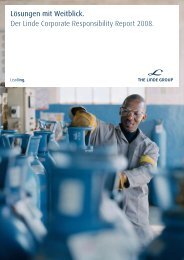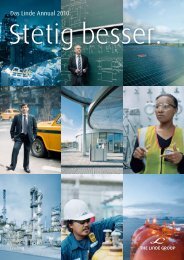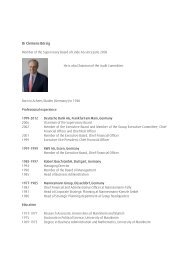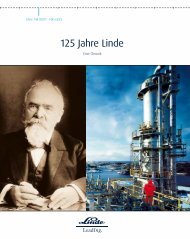The complete history of the development of The - The Linde Group
The complete history of the development of The - The Linde Group
The complete history of the development of The - The Linde Group
Create successful ePaper yourself
Turn your PDF publications into a flip-book with our unique Google optimized e-Paper software.
Güldner Motoren-Gesellschaft mbH:<br />
from diesel engines to tractors and forklifts<br />
Hugo Güldner, co-founder and namesake <strong>of</strong><br />
Güldner Motoren-Gesellschaft mbH<br />
<strong>The</strong> gradual takeover <strong>of</strong> Güldner Motoren-<br />
Gesellschaft mbH in Aschaffenburg by<br />
1929 caused a major change in <strong>the</strong> <strong>Linde</strong><br />
Company: It helped <strong>the</strong> engineering company<br />
to grow into a major machine builder,<br />
which started out in <strong>the</strong> 1960s to garner<br />
<strong>the</strong> world market for industrial trucks,<br />
especially forklifts.<br />
<strong>The</strong> <strong>Linde</strong> – Güldner connection goes<br />
back to 1904, when Carl von <strong>Linde</strong> founded<br />
Güldner Motoren-Gesellschaft mbH along<br />
with Hugo Güldner and o<strong>the</strong>r partners,<br />
and took a seat on <strong>the</strong> Supervisory Board.<br />
In 1908 <strong>the</strong> <strong>Linde</strong> Company took on partial<br />
ownership <strong>of</strong> this company for <strong>the</strong><br />
first time. When Güldner began to have<br />
financial problems in 1925, <strong>the</strong> <strong>Linde</strong><br />
Company purchased additional shares.<br />
<strong>The</strong>n, during <strong>the</strong> Great Depression <strong>of</strong><br />
1929, Güldner came under <strong>complete</strong><br />
ownership <strong>of</strong> <strong>Linde</strong>.<br />
36<br />
1924 1925<br />
German chemists discover polyvinyl alcohol, <strong>the</strong> basis<br />
for <strong>the</strong> manufacture <strong>of</strong> artificial fibers and films.<br />
Starting in <strong>the</strong> late 1930s, tractors<br />
became <strong>the</strong> company’s main product<br />
group aside from engines. But in 1952 its<br />
tractor business was in <strong>the</strong> red, a situation<br />
that was not changed by <strong>the</strong> introduction<br />
<strong>of</strong> air-cooled diesel engines in 1954 ei<strong>the</strong>r.<br />
Güldner made a technological leap into<br />
<strong>the</strong> future in 1955 with <strong>the</strong> continuous<br />
hydrostatic drive, which was first installed<br />
in <strong>the</strong> “Güldner Hydrocar” transport vehicle.<br />
In 1969, <strong>Linde</strong> ceased production <strong>of</strong><br />
tractors and diesel engines in order to<br />
concentrate on <strong>the</strong> high-growth sectors<br />
<strong>of</strong> industrial trucks and hydraulics. Over<br />
<strong>the</strong> ensuing years, this division developed<br />
into one <strong>of</strong> <strong>the</strong> <strong>Linde</strong> <strong>Group</strong>’s main support<br />
pillars with strong sales and income.<br />
N o 0658 Process for <strong>the</strong> separation<br />
<strong>of</strong> coke oven gas by means <strong>of</strong> intense cooling.<br />
Werner Karl Heisenberg presents his<br />
<strong>the</strong>ory <strong>of</strong> quantum mechanics.<br />
No 0667Process and<br />
device for <strong>the</strong> condensation <strong>of</strong> vapors<br />
contained in air and o<strong>the</strong>r gases by<br />
means <strong>of</strong> cooling.<br />
<strong>The</strong> entry into machinery building at first had an hindering<br />
effect. In order to improve <strong>the</strong> situation <strong>of</strong> Maschinenfabrik<br />
Sürth, which was taken over in 1920, <strong>the</strong> <strong>Linde</strong> Company<br />
acquired <strong>the</strong> G.H. Walb & Co. refrigerated appliance factory in<br />
Mainz-Kos<strong>the</strong>im, which initially handled <strong>the</strong> sale <strong>of</strong> <strong>the</strong> small<br />
refrigeration machines made by Sürth.<br />
In 1922, <strong>Linde</strong> purchased shares in Heylandt Gesellschaft für<br />
Apparatebau <strong>of</strong> Berlin, simultaneously acquiring <strong>the</strong> company’s<br />
patents for low-temperature engineering and process technology<br />
(see also page 38).<br />
Finally, in 1929, <strong>the</strong> <strong>Linde</strong> Company also purchased all <strong>of</strong> <strong>the</strong><br />
shares in Güldner Motoren-Gesellschaft mbH, which Carl von<br />
<strong>Linde</strong> had co-founded in 1904. This company was later moved to<br />
Aschaffenburg (see also page 52). That move, which was actually<br />
motivated with social welfare in mind, would in hindsight be<br />
seen as a major milestone, as it made possible <strong>the</strong> later entry<br />
in tractor manufacturing – and even more importantly, Güldner<br />
became <strong>the</strong> seed from which today’s Material Handling Business<br />
Segment grew.<br />
Modernization and innovation<br />
Friedrich <strong>Linde</strong> and particularly his bro<strong>the</strong>r-in-law Rudolf Wucherer<br />
made use <strong>of</strong> <strong>the</strong> difficult years <strong>of</strong> <strong>the</strong> post-war period to modernize<br />
<strong>the</strong>ir gas operations and streamline <strong>the</strong>ir organization. At <strong>the</strong><br />
same time, Richard <strong>Linde</strong> in Department B (gas liquefaction and<br />
separation) worked on <strong>the</strong> technological optimization <strong>of</strong> <strong>the</strong> <strong>Linde</strong><br />
process. Engineers increased <strong>the</strong> purity <strong>of</strong> <strong>the</strong> oxygen from <strong>Linde</strong><br />
plants from 98 to 99 percent and that <strong>of</strong> nitrogen to 99.999 percent.<br />
At <strong>the</strong> same time <strong>the</strong>y reduced <strong>the</strong> plants’ energy consumption.<br />
<strong>The</strong>y also developed a process for separating coke oven gas<br />
to produce a mixture <strong>of</strong> hydrogen and nitrogen for <strong>the</strong> syn<strong>the</strong>sis<br />
<strong>of</strong> ammonia. <strong>Linde</strong> sold one <strong>of</strong> <strong>the</strong> first plants <strong>of</strong> this type to a<br />
Belgian customer in 1924. In <strong>the</strong> years to follow up until 1928,<br />
<strong>the</strong> company had sold or booked orders for 47 such plants <strong>of</strong><br />
various sizes.




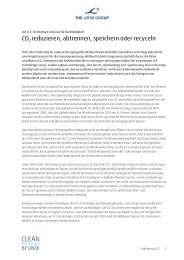

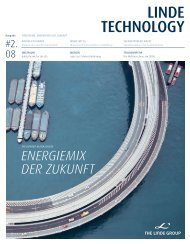

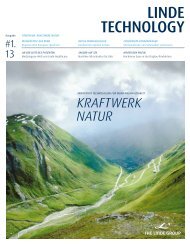
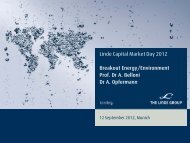
![[41] Anteilsbesitzliste des Linde Konzerns und ... - The Linde Group](https://img.yumpu.com/8356102/1/184x260/41-anteilsbesitzliste-des-linde-konzerns-und-the-linde-group.jpg?quality=85)
![[41] Anteilsbesitzliste des Linde Konzerns und ... - The Linde Group](https://img.yumpu.com/8356076/1/184x260/41-anteilsbesitzliste-des-linde-konzerns-und-the-linde-group.jpg?quality=85)
